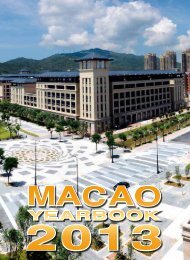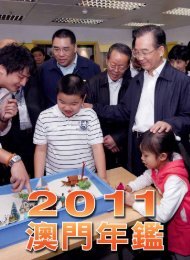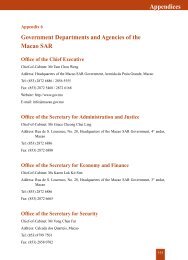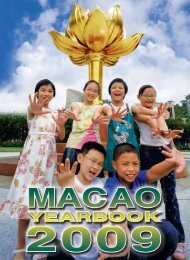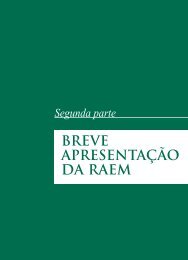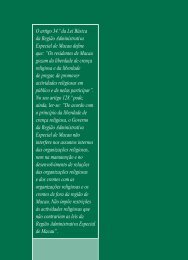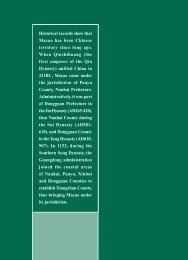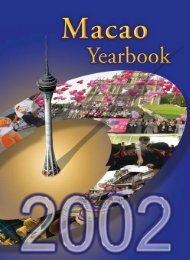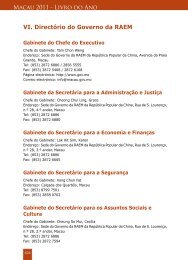Culture and Sport - Macao Yearbook
Culture and Sport - Macao Yearbook
Culture and Sport - Macao Yearbook
You also want an ePaper? Increase the reach of your titles
YUMPU automatically turns print PDFs into web optimized ePapers that Google loves.
Dr Sun Yat Sen Memorial House<br />
<strong>Culture</strong> <strong>Culture</strong> <strong>and</strong> <strong>and</strong> <strong>Sport</strong> <strong>Sport</strong><br />
Originally built by Dr Sun Yat Sen as a home for his family in the years after 1918, this Islamic<br />
style residence was opened as Dr Sun Yat Sen Memorial House in 1958.<br />
It contains furniture <strong>and</strong> other items used by Dr Sun when he practised medicine in <strong>Macao</strong>, <strong>and</strong><br />
when he was the Great Comm<strong>and</strong>er in Guangzhou. Among its collections are calligraphy by Dr<br />
Sun <strong>and</strong> photos he took with his martyr-comrades of the 1911 Revolution. There is also a bronze<br />
statue of Dr Sun in the garden, where visitors can pay their respects.<br />
Lin Zexu Museum<br />
The Lin Zexu Museum in Lin Fong Temple was completed in November 1997, in memory of Imperial<br />
Commissioner Lin Zexu, who defied the powerful <strong>and</strong> the mighty to institute a ban on opium <strong>and</strong><br />
the opium trade. On 3 September 1839, Lin Zexu, who was then in charge in Guangdong, <strong>and</strong> Deng<br />
Tingzheng, the Governor of Guangdong <strong>and</strong> Guangxi, met the Consul of the former Portuguese<br />
administration to proclaim the prohibition of opium <strong>and</strong> China’s sovereignty over <strong>Macao</strong>.<br />
The museum displays pictures showing opium being destroyed in Humen, <strong>and</strong> the old days in<br />
<strong>Macao</strong>. It also houses documents on Lin Zexu’s communications with the imperial government,<br />
as well as models of Chinese Qing Dynasty warships <strong>and</strong> Portuguese vessels, <strong>and</strong> the types of<br />
boats used to carry opium. Life-sized tableaux show Lin’s meeting with foreign officials. There are<br />
instruments used by opium addicts too: a reminder to visitors not to forget the evils of drug addiction.<br />
Fire Service Museum<br />
Founded in December 1999, the Fire Service Museum is located inside the central operational fire<br />
station on Repouso Road. It is open to the public, <strong>and</strong> received 31,573 visitors in 2011.<br />
The museum has two exhibition halls designed in different styles, which occupy a total area of 350<br />
square metres. The main hall’s display – of vintage manual water pumps made in China <strong>and</strong> Britain,<br />
two old-style British fire engines, various historical artefacts <strong>and</strong> pictures, <strong>and</strong> fire service flags,<br />
emblems, decorations <strong>and</strong> badges – is designed to help visitors underst<strong>and</strong> the bureau’s development<br />
over the years. The inner exhibition hall contains a model of the Fire Service’s central station, an<br />
electronic board showing the distribution of operational fire stations, firemen’s helmets <strong>and</strong> boots,<br />
water nozzles, various fire appliances, protective equipment, pictures of disasters that have happened<br />
in <strong>Macao</strong>, <strong>and</strong> a model simulating the scene of a fire in a squatter hut area. The museum aims to<br />
increase the knowledge of visitors about fire appliances, <strong>and</strong> enhance their underst<strong>and</strong>ing of the<br />
damage that fires can cause, thereby raising their awareness about the importance of fire prevention.<br />
Museum of Nature <strong>and</strong> Agriculture<br />
The first museum to be built on Coloane isl<strong>and</strong>, the Museum of Nature <strong>and</strong> Agriculture, under<br />
the Civic <strong>and</strong> Municipal Affairs Bureau, is within the Seac Pai Van Country Park. Built by the<br />
then Municipal Council of the Isl<strong>and</strong>s, the museum was opened on 21 March 1997. It is a cultural<br />
amenity with an educational purpose.<br />
The museum’s five thematic exhibitions are devoted to the Geography of <strong>Macao</strong>, Farming<br />
351



